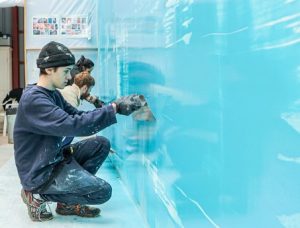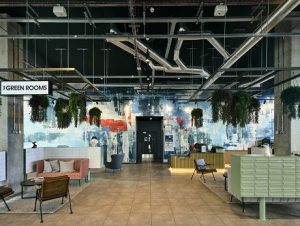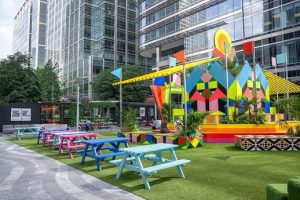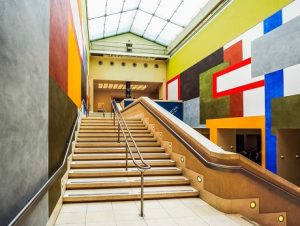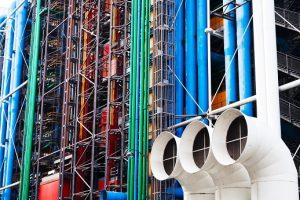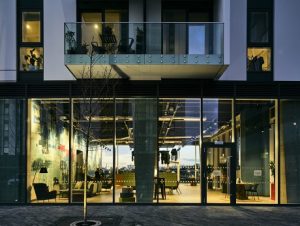There is more to art than meets the eye. If artistic intent and involvement are embedded and harnessed from the outset of a project there can be manifold benefits to BTR buildings, staff, residents and investor-operators.
“Beyond art for art’s sake,” which is “intrinsically worthwhile”, “art can also be instrumental.”
In communities, art can have positive social impact, and one that is good for business too; helping to de-risk planning objections, integrate schemes within the local community, create distinctive long-term identity for a development, and support resident acquisition, wellbeing, and retention. Art adds asset value and builds community value.
- Cubo, 2013, Centre Pompidou, Malaga. Pic: Pabkov
- Colourful Umbrellas, 2015, Timisoara, Romania. Pic: Catalin Lazar
What do we mean by art? Art could be permanent (pieces such as sculptures, architectural, kinetic, integrated 2D or 3D installations, furniture, murals, landmarks), ephemeral or participatory (audio-visual installations, exhibitions, events, theatre, festivals, performance-based art), or in the form of interior commissions (fine and applied art, and bespoke installations).
Inclusion of art (actioned in an integrated way) is a keystone strategy in de-risking planning objections for community and investment stakeholders. Uniquely, it creates possibilities for linking up with art schools, universities and local charities to deliver projects, and encourages a process of co-creation and collaboration.
This in turn generates community engagement and meaningful social impact, enabling a project to be perceived and received in a positive light and as a symbol of aspiration; making art a very effective tool for helping to integrate a development within its physical and socio-economic context.
- Manchester School of Art students creating a fresco for MediaCityUK. Pic: Samuel Callen
- The Green Rooms lobby fresco, Aster Muro, 2020, MediaCityUK. Pic: Gu Shi Yin
- Picnic area installation, The Canary Wharf Summer Light Festival, 2021. Pic: CK Travels
For instance, with planning considerations and section 106 obligations mitigating impact on local community, South Cambridgeshire District Council encourages developers to dedicate 1-5% of associated construction costs of the capital project to public art.
Enhancing communities with a visionary and innovative art strategy integrated into the fabric and spirit of the building is a convincing way to approach planning. Introduction to local creative and art infrastructure is a positive for planners and for garnering support from the local community; in essence, art de-risks development.
Capturing the ‘genius loci,’ art initiates inclusivity, sensitively creating a bond and shared narrative, and mediating the integration of the new community with the existing one.
The intrinsic value of the physical asset is enhanced by its relationship with the non-physical aspects such as memory, experience, and common identity. It is important to recognise that positive emotional reactions add real and tangible value to a development; indeed it is the ability to communicate emotionally that lies at the heart of all successful brands. BTR is no different.
The prize of reconnecting planning with art is nothing less than putting the soul and spirit back into the places we makeTown and Country Planning Association
According to the Town and Country Planning Association (TCPA): “The prize of reconnecting planning with art is nothing less than putting the soul and spirit back into the places we make.”
Employing fundamental principles of urban design that improve the quality of the built environment is a positive socio-cultural contribution and leads to greater chances of acceptance and mitigation of risk.
Research published by the All Party Parliamentary Group on Arts, Health and Wellbeing (APPGAHW) in 2017 sets out comprehensive evidence and numerous examples of practice which demonstrate the beneficial impact of the arts, stating that 85% of people in England agree that the quality of the built environment influences the way they feel.
The Chartered Association of Building Engineers (CABE) also declared the “need for a long-term approach to building that prioritised the health and wellbeing of users”.
And, when it comes to the role of art in this, research by Mark Biernbaum showed: “No community planning efforts should be made without an artist on board.” (Biernbaum, Mark A., ‘Notes on the Arts and Social Capital’)
The immediate and long-term identity of the asset can be shaped by using art to create a strong narrative that runs through the building in the amenity spaces and meeting places.
A ‘Brand Before Building’ approach contributes positively to community, de-risks planning, secures resident acquisition and retention – and therefore income.
- Drawing for Free Thinking, David Tremlett, 2011, in the Manton Staircase, Tate Britain. Pic: Claudio Divizia
- Pompidou Centre, Paris, 1977. An inside-out building which is an installation in itself. Pic: Vvoe
- The Green Rooms lobby fresco. Shared by residents and passers-by, it is integral and public. Pic: Gu Shi Yin
Identity is the foundation for legacy, based on value and joy for residents.
Art that is integral to the building tells a story that becomes timeless, drawing from the locality to create an individual identity that is an original and intrinsic part of the landscape.
A strong identity generates a desirable pride of place, is distinctive, unique and characterful. It can also aid promotion and forge a greater sense of local identity, belonging and ownership for residents and communities.
Art is vital in opening the door to creating the sorts of places that people want to live in, both understanding and expressing what it is to be human. It is true, as the TCPA says: “People need art in their everyday lives to thrive and connect.”
The Green Rooms BTR development in MediaCityUK won the Homeviews BTR Resident Choice Award in 2020 and secured a Top 10 in the same category in 2021.
It is here in the lobby that the Aster Muro studio created a vast 80sqm abstract fresco, involving foundation students from Manchester School of Art, and which is visible also to the public en route to the BBC.
Abstract frescoes are an art form well-suited to BTR, focusing on building a general narrative and distinct identity at large scale, existing integrally within the building, strengthening the overall proposition.
Timeless and democratic, frescoes encourage an individual response alongside simultaneous connection to the general. The identity is formed with colour and warmth, and the narrative is positive and inclusive.
A further sense of attraction, recognition and identification arises through placement in a public, prominent and visible position, creating an attractive and meaningful gateway, focal point and meeting place.
Helping to create internal community and wellbeing results in resident retention and, with resident acquisition, this leads to stable income and better management of revenue risk.
Both permanent installations and exhibition spaces that change over time in amenity areas are a generous offer and dynamic selling point.
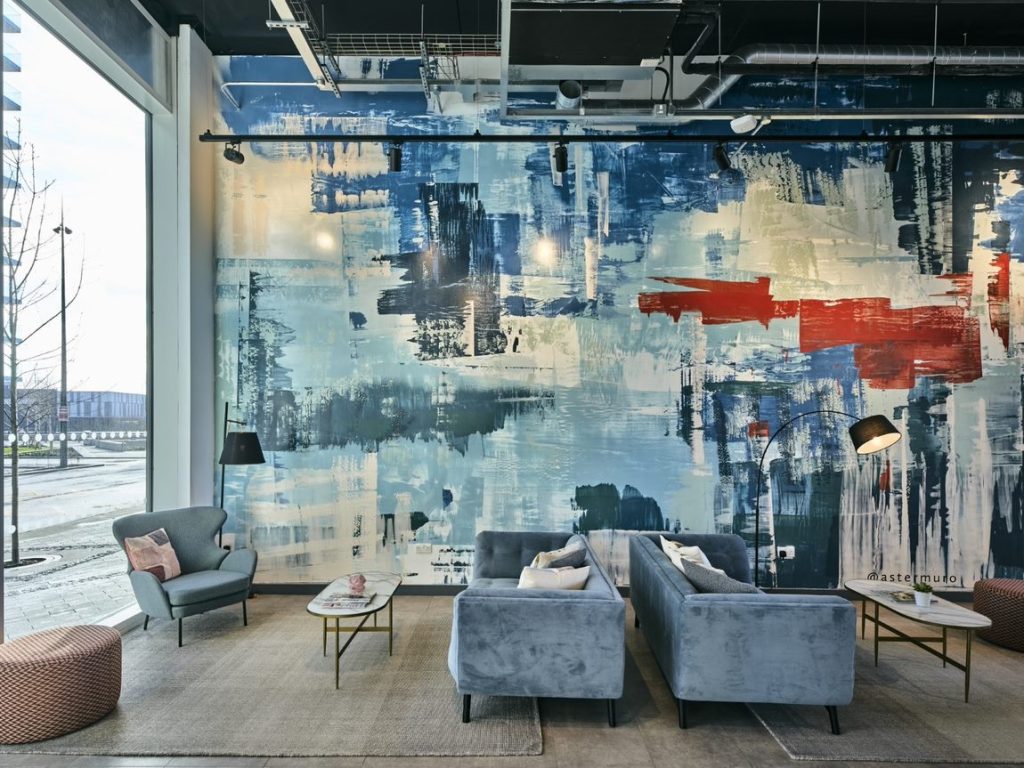
The Green Rooms lobby fresco, detail. Residents of the Green Rooms, MediaCityUK, are greeted by the permanent installation in the lobby. Pic: Gu Shi Yin
Artist Grayson Perry is quoted in the APPGAHW report. He said: “Art helps us access and express parts of ourselves that are so often unavailable to other forms of human interaction. It flies below the radar, delivering nourishment for our soul… lifts our spirits and keeps us sane.”
Indeed, an article in The Guardian noted that “some companies consciously use art as part of their retention strategy” knowing that “if you enrich a space people feel much happier… a very good way of doing this is by using art”.
For BTR, art can warm the business plan and the building, like heating an engine and fluids before driving a vehicle. Art can reduce the risk of damage from cold starts and idling, allowing the engine of BTR to quickly reach an ideal operating temperature and to perform more smoothly. Art can enrich, identify, empower, connect, and facilitate. It is intrinsic and valuable.
In the longer term it helps to create an enhanced legacy, reinforcing a project with strong identity and integration, with better community acceptance and entrenchment adding value over subsequent decades.
Art is the seed for a latent release of value; an integral part of the value stream of BTR at every step of the way.
“Good design is about creating a place that functions well, both now and in the future. It should also be attractive, providing an inspirational and special place for people.” (CABE, It’s Our Space, 2007. p.1).


